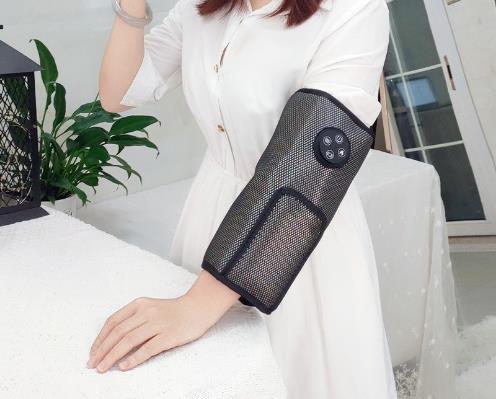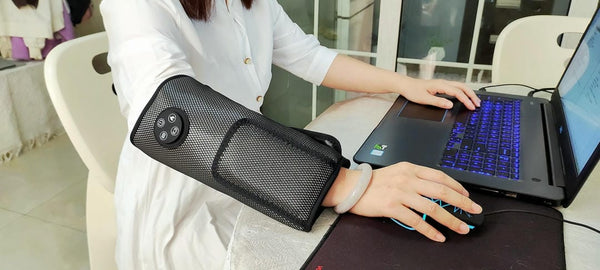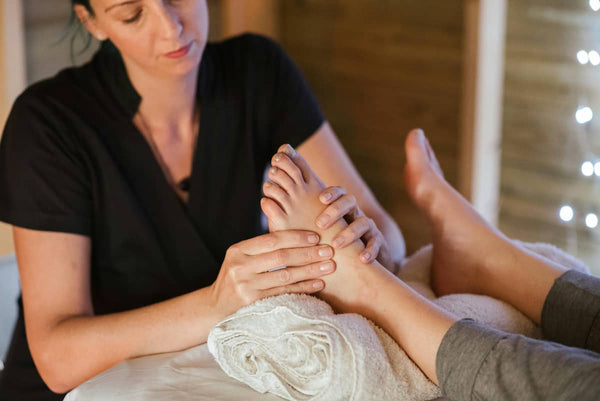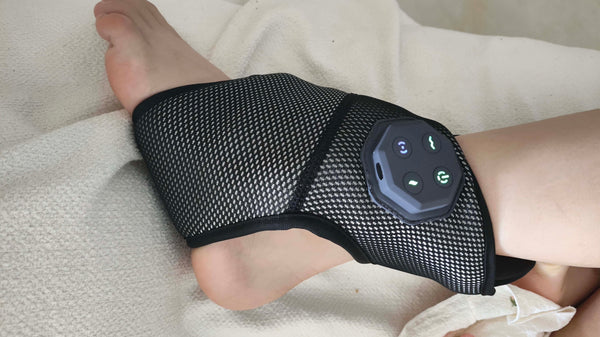
Navigating the path to recovery after a knee injury can be a frustrating journey, especially for those accustomed to an active lifestyle. In my years of practice, I've seen how the right support can make a world of difference. Proper massage equipment can be a powerful ally, helping to manage pain, reduce swelling, and restore mobility. However, it's a double-edged sword. The wrong tool or an improper technique can easily set back your progress. This guide is designed to cut through the confusion and provide a clear, safe roadmap for using massage to support your knee's healing process.
We'll explore how to select the appropriate tools for each stage of your recovery. The goal isn't just about feeling better in the moment; it's about creating an environment where your body can heal efficiently and effectively. Think of your body's energy and circulation, its Qi, as a river. An injury creates a blockage. Our task is to gently clear the debris around the blockage, not blast it with force, allowing the river to flow freely once more. This is key when choosing any massage equipment for such a sensitive area.
Understanding Knee Pain & The Role of Massage
When you injure your knee, the body initiates a complex inflammatory response. This brings swelling, pain, and often "muscle guarding"—where the muscles around the joint, like your quadriceps and hamstrings, tighten up to protect it. While this is a natural defense mechanism, prolonged tightness can restrict blood flow, slow down healing, and lead to stiffness and scar tissue formation. And that, to be honest, is where many secondary problems begin.
This is where targeted massage comes in. By focusing on these supporting muscles—not the joint itself—we can achieve several crucial goals. We can improve circulation, bringing oxygen-rich blood to the area and carrying away waste products. This helps reduce swelling and nourishes the healing tissues. From a traditional perspective, we are encouraging the smooth flow of blood and Qi, which are fundamental for repairing and rebuilding. The right massage equipment acts as an extension of a therapist's hands, allowing you to facilitate this process at home.
Why the Right Massage Approach is Crucial for Recovery
The distinction between helpful and harmful intervention is never more critical than with a healing joint. Have you ever wondered why aggressive massage can sometimes make things worse? Applying deep, direct pressure to an inflamed or recently repaired knee can aggravate the injury, increase inflammation, and even damage delicate, healing ligament or cartilage tissues. It's like trying to fix a delicate watch with a hammer. You need precision, gentleness, and an understanding of the underlying mechanics.
A proper approach, using suitable massage equipment, yields significant benefits:
- Pain Management: Gentle massage on surrounding muscles can interrupt pain signals sent to the brain and release natural endorphins.
- Reduced Swelling: By stimulating the lymphatic system, you can help drain excess fluid away from the joint.
- Improved Range of Motion: Releasing tension in the quads, hamstrings, and calves allows the knee joint to move more freely without being pulled and strained by tight muscles.
- Prevention of Scar Tissue: Controlled, gentle motion and massage can help new collagen fibers lay down in an organized, flexible way rather than as a stiff, restrictive patch.
The key is to always work around the joint, treating the support structures to create a stable and healthy environment for the knee to recover. This is where your choice of massage equipment becomes a critical decision.
Recommended Massage Equipment for Different Recovery Stages
Your recovery journey is not a single event; it's a process with distinct phases. The tools you use must adapt to what your body needs at each stage. Using a tool meant for deep tissue work during the acute inflammatory phase is a recipe for disaster. Let's break down the ideal massage equipment for each phase.
 Stage 1: Acute Phase (Post-Injury or Post-Surgery)
Stage 1: Acute Phase (Post-Injury or Post-Surgery)
In this initial phase, the primary goals are to manage pain and control swelling. Everything should be gentle. The focus is on calming the area, not aggressively treating it. Direct pressure on the knee is absolutely off-limits.
- Gentle Vibrating Massagers: A device that provides gentle, high-frequency vibration (like the KLCOSY massager, as an example of type) can be excellent. The vibration provides soothing sensory input that can help override pain signals. Use it on the thigh (quadriceps) and calf muscles, always avoiding the kneecap and any surgical incisions.
- Cold/Hot Therapy Wraps: These are essential massage supplies. Cold therapy (cryotherapy) in the first 48-72 hours is crucial for constricting blood vessels to reduce swelling and numb pain. Later, gentle heat can be applied to surrounding muscles (never the swollen joint) to promote blood flow.
Stage 2: Sub-acute & Remodeling Phase (Healing & Strengthening)
As the initial swelling and intense pain subside, you can begin to work more on muscle flexibility and breaking down minor adhesions. You are still avoiding the joint itself, but the work on the surrounding muscles can become more specific. This is where you might look for more advanced massage products.
- Foam Rollers: A foam roller is a fantastic tool for the large muscles that support the knee. Gently roll your quadriceps, hamstrings, IT band (the side of your thigh), and calves. The key is to control the pressure with your own body weight and to stop if you feel any sharp pain in the knee.
- Massage Balls: For more targeted relief, a lacrosse or a dedicated massage ball is perfect for digging into trigger points in the calf or gluteal muscles. Releasing tightness in the glutes is surprisingly important, as they play a huge role in stabilizing the entire leg and influencing knee alignment.
- Percussion Massage Guns (with extreme caution): These popular devices can be used, but with strict rules. Use only the softest, padded attachment. Keep it on the lowest speed setting. And most importantly, use it *only* on the thick, fleshy parts of your thigh and calf muscles, staying far away from the kneecap, shin bone, and the sides of the knee where ligaments are located.
CRITICAL WARNING: Equipment and Techniques to AVOID Without Professional Guidance
This is the most important section of this guide. While the right massage equipment can aid recovery, the wrong application is dangerous. Without the direct supervision of a physical therapist or doctor, you must avoid the following:
- ANY Direct Pressure on the Knee Joint: Never use a foam roller, massage gun, or your hands to apply pressure directly onto the kneecap, the sides of the knee, or the hollow behind it. This can cause serious damage.
- Aggressive Compression Systems: While a simple compression sleeve can be helpful, avoid powerful, mechanical full-leg compression systems that squeeze the joint itself, especially in the early stages. This kind of forceful apparatus massage can disrupt the healing process.
- Forced Stretching or Deep Squatting: Do not use massage tools to push your knee into a deeper stretch or squat than it can comfortably achieve on its own. This can easily re-tear healing tissues. Your flexibility and strength must be rebuilt gradually through prescribed exercises.
Tips for Maximizing Your Home Recovery Routine
To get the most out of your efforts, remember these guiding principles. First and foremost, listen to your body. Pain is a signal to stop, not to push through. What feels good one day may be too much the next. Consistency is also far more important than intensity. Five to ten minutes of gentle, focused work each day is more beneficial than one painful, hour-long session per week.
Always integrate this work with the exercises and advice given to you by your physical therapist. Your massage equipment is a supplement to, not a replacement for, professional rehabilitation. When sourcing your tools, whether you're looking for specialist massage equipment Australia-based suppliers offer or just searching online for "massage supplies near me", always prioritize quality over price. A poorly made tool can break or provide inconsistent pressure, posing a risk to your recovery.
In conclusion, choosing the right massage equipment for a knee injury is about wisdom and precision, not power. It's about understanding that healing happens around the joint, in the muscles and tissues that support it. By selecting gentle tools in the acute phase and progressing to more specific instruments as you heal, you can significantly support your body's natural recovery process. Always remember the critical warnings, listen to your body, and work in harmony with professional medical advice. Your knee is a complex and vital joint; treat it with the respect and care it deserves on its path back to strength and stability.
Frequently Asked Questions
What massage equipment is essential for a home spa?
For a general home spa experience focused on relaxation and wellness rather than specific injury recovery, I'd recommend a foundational set. Start with a high-quality handheld massager with interchangeable heads for versatility—some for gentle relaxation, others for deeper muscle work. A good neck and shoulder massager with heat is also invaluable for releasing common tension. Finally, consider a simple foot spa or a foot roller. These items provide a holistic experience, addressing the areas where we commonly hold stress, and don't require extensive technical knowledge to use safely.
How to compare massage equipment for commercial vs. home use?
The primary differences are durability, power, and specificity. Commercial massage equipment, like that used in a physiotherapy clinic, is built for continuous, all-day use on multiple clients. It has stronger motors, more robust construction, and often more precise control settings. Home-use equipment is designed for intermittent use by one or two people. While a high-end home percussion massager might feel powerful, a commercial one will maintain that power for much longer without overheating. For home use, focus on user-friendliness, safety features, and good ergonomics. For commercial use, the focus is on performance endurance and warranty.
Is massage equipment worth the investment for pain management?
From my professional experience, absolutely—provided it's the *right* investment for your specific needs. For chronic pain conditions like general muscle tightness from office work or fibromyalgia, having a tool for daily relief can be life-changing and cost-effective compared to frequent professional visits. For an acute injury, like the knee issues we've discussed, its value is in safely supplementing a professional recovery plan. The investment is "worth it" when the user is educated on how to use the tool correctly. A $500 massage gun used improperly is worthless and potentially harmful, while a $20 massage ball used correctly can provide immense, lasting relief.




0 comments